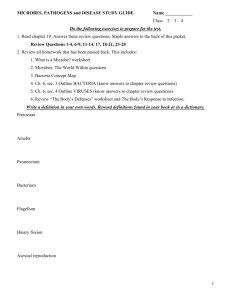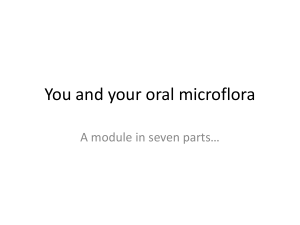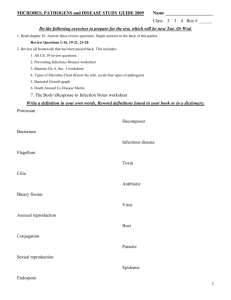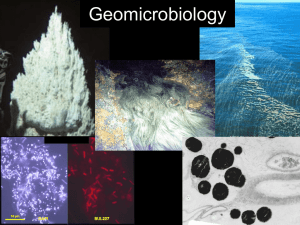20.106J – Systems Microbiology Lecture 17 Prof. Schauer
advertisement
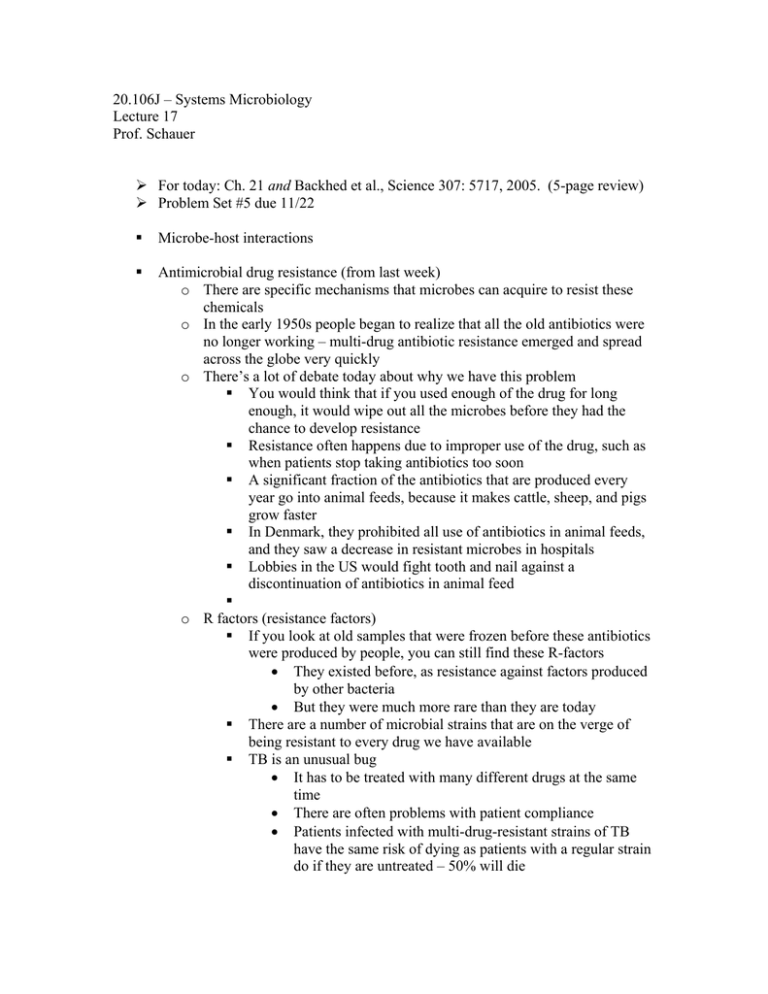
20.106J – Systems Microbiology Lecture 17 Prof. Schauer ¾ For today: Ch. 21 and Backhed et al., Science 307: 5717, 2005. (5-page review) ¾ Problem Set #5 due 11/22 Microbe-host interactions Antimicrobial drug resistance (from last week) o There are specific mechanisms that microbes can acquire to resist these chemicals o In the early 1950s people began to realize that all the old antibiotics were no longer working – multi-drug antibiotic resistance emerged and spread across the globe very quickly o There’s a lot of debate today about why we have this problem You would think that if you used enough of the drug for long enough, it would wipe out all the microbes before they had the chance to develop resistance Resistance often happens due to improper use of the drug, such as when patients stop taking antibiotics too soon A significant fraction of the antibiotics that are produced every year go into animal feeds, because it makes cattle, sheep, and pigs grow faster In Denmark, they prohibited all use of antibiotics in animal feeds, and they saw a decrease in resistant microbes in hospitals Lobbies in the US would fight tooth and nail against a discontinuation of antibiotics in animal feed o R factors (resistance factors) If you look at old samples that were frozen before these antibiotics were produced by people, you can still find these R-factors • They existed before, as resistance against factors produced by other bacteria • But they were much more rare than they are today There are a number of microbial strains that are on the verge of being resistant to every drug we have available TB is an unusual bug • It has to be treated with many different drugs at the same time • There are often problems with patient compliance • Patients infected with multi-drug-resistant strains of TB have the same risk of dying as patients with a regular strain do if they are untreated – 50% will die Some R-factors reside on the plasmid, so that they can be easily transferred from one microbe to another o Healthcare-associated infections (HAIs) o Methicillin-resistant Staphylococcus aureus N315 Penicillin binding protein Terminology o “Normal flora” – it’s normative (most people have it), and “flora” means plant growth Clearly, this is imprecise, since microbes in our gut aren’t plants Microbiota is a better term o Commensal Symbiotic – the biology is interwoven, and both we and the microbes benefit This is colonization (as opposed to infection) o Pathogen Not all pathogens cause disease in all individuals They might cause infection but not illness If you’re infected with TB, you’re not going to die from TB – you’re going to die from the infection and disease that it causes What kinds of problems the microbe might or might not cause have to do with the virulence of the strain, your own immune reaction, environmental factors, age, etc. If you maintain a stable relationship with the microbe, regardless of whether it causes disease, it is an infection o Opportunistic pathogens They take advantage of defects in host defenses, so that people with some kind of immodeficiency can get much much sicker Indigenous microbiota o The replication of bacteria on our skin is limited by the skin’s relative dryness For that reason, the development of bacteria on the skin is usually associated with sweat glands, etc. o There’s a relatively simple population of bacteria that lives on the gums of babies, before they develop teeth It gets more complicated when the teeth develop Bacteria develop into a complex community, involving plaque, etc. – it’s a very complex community, which people have spent a lot of time studying Oxygen depletion There’s the prospect of a potential vaccine against tooth decay Some of the bacteria from your mouth get into your bloodstream • These bacteria can cause problems for people with artificial heart valves, and in general they can cause the risk of heart infections o The GI tract carries 100-fold more bacteria than the skin (1014) o Diagram of the human GI tract Most of the microbes live in the colon It’s an anaerobic environment They produce vitamin K and B12, which we can’t produce on our own o Kids are born sterile, and they start to take in microbes when they breastfeed There’s a very complex, predictable sequence in which children develop different microbes as they grow o Our genes determine how we respond to different microbes For example, when an appendix ruptures and releases microbes into the peritoneal cavity, it can make you very sick But when you inject these microbes into the peritoneal cavity of a rat, there are genes that influence whether it makes the rat very ill o Antibiotics put people at risk of thrush or yeast infections These microbes protect us, and without them we can get sick, such as with diarrhea or skin infections o We don’t know very much about our natural flora We don’t know exactly which microbes are there in what proportions Therefore it’s difficult to know how to restore these beneficial microbes after the use of antibiotics Some people say yogurt helps o The actual population of our gut does not change very much depending on what we eat – it’s pretty stable People hadn’t originally expected this to be the case Model Systems o You can create germ-free animals by deriving them in an environment where there are no microbes around To do this, you do time-precise mating, birth them with a ceasarian section, and then keep them in a completely sterile environment You need to feed them every hour round the clock with a completely sterile milk or milk replacement – so it’s very labor intensive o These animals will actually be able to grow and reproduce, though you have to supplement them with vitamin K and B12 o Mice have a large cecum, which contains a large population of microbes that will digest cellulose for them, so they can survive on poorer diets than we can Human colonic microbiota o Most of the species in our gut are uncultured – we’ve never grown them in a lab before, and we know very little about them o Compared to samples of bacteria in environments like seawater, the community in our gut is really very limited in variety Only 8 of the known 55 bacterial divisions are present Protobacteria are present, but not all that common o Diversity: over 7000 strains Helicobacter pylori – an interesting story o Barry J. Marshall and J. Robin Warren shared the Medicine Nobel in 2005 for the discovery of these microbes o Barry Marshall was a gastroenterology fellow who was working for Warren, a pathologist who thought he saw microbes in samples from the stomach o They were trying to grow these microbes, which they eventually succeeded in doing o Marshall succeeded in showing that these microbes caused stomach ulcers by drinking a culture of the bacteria o Previously, doctors had been prescribing very expensive acid-suppressor drugs, when all they really needed was antibiotics. Very invasive procedures had been common for people where the acid-suppressor drugs weren’t working. o Later, it was proven that these bacteria also cause cancer – they’re a class 1 carcinogen o About a third to half of the human population is infected with HP, but only a relatively small proportion of these people will develop ulcers or gastric cancers from it o H. pylori don’t cause disease by themselves, they cause infection. The disease is the result of a very complicated immune response. Something about the immune response does not effectively eradicate the infection. o It’s the host response that leads to eventual ulcers and possible cancers o There’s a significant population of people around the world that has H. pylori and can’t afford antibiotics, so they are at risk for cancer.\ Pathogens have different kinds of immune response depending on their complement, and if our own host response isn’t 100% effective, it can in turn cause inflammation and cancer.


